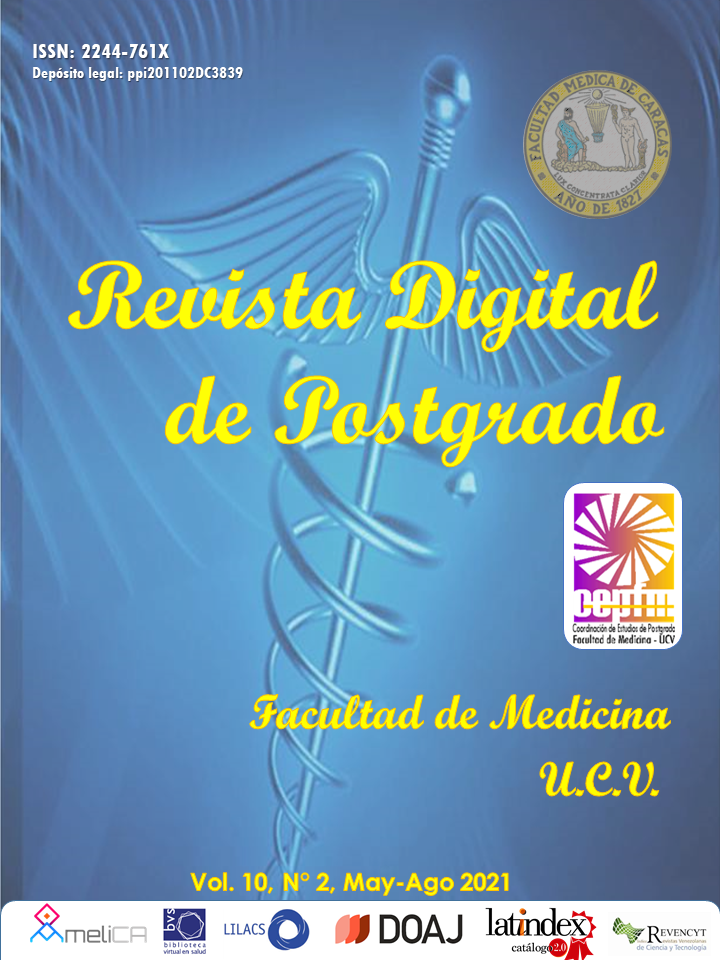Cauda equina syndrome following subarachnoid administration of hyperbaric bupivacaine 0.75 %
Keywords:
bupivacaine, syndrome, cauda equina, pain, subarachnoid anesthesia.Abstract
Cauda equina syndrome is a rare pathology in the area of anesthesiology. This is characterized by presenting a set of signs and symptoms that involve: pain, decrease or abolition of muscle strength, sphincter dysfunction and saddle hypoesthesia. The objective of this work is to present and discuss the clinical case of a patient with a diagnosis of cauda equina syndrome after the administration of hyperbaric 0.75% bupivacaine via the subarachnoid route. This is a 42-year-old female patient who underwent segmental cesarean section and bilateral salpingectomy with subarachnoid anesthetic block; and who subsequently at sixteen hours postoperatively presented: decreased muscle strength, lower limbs and hypoesthesia of the saddle region, knee jerk reflex: bilateral 0/4 and urinary retention. Pharmacological and physical treatment was started immediately, the diagnosis of cauda equina syndrome was established. The patient was discharged on postoperative day 10, with a significant decrease in the symptoms described above, later evidence of urinary retention, requiring intermittent bladder catheterization. Once the diagnosis was established, pharmacological and physiatric treatment was immediately installed to give a timely resolution of the pathology.Downloads
References
Natálio A, Araújo F, Cristante A, Marcon R, Pessoa T, Letaif O. Epidemiology of cauda equina syndrome. What changed until 2015. Rev Bras Ortop. 2018; 53 (1):107-112.
Ponce E, Rodríguez R. Síndrome de cauda equina secundario a hematoma epidural espontaneo. An Med (Mex). 2014; 59 (4):304-309.
Merino W, Villagrán M, Ulloa P, Carrasco R, Uribe A, Stoicea N, et al. Cauda equina syndrome following an uneventful spinal anesthesia in a patient undergoing drainage of the Bartholin abscess: A case report. Medicine (Baltimore) [Internet]. 2018 May[cited 2020 Jul 30];97(19):e0693–e0693. Available from: https://pubmed.ncbi.nlm.nih.gov/29742719
Tseng W-C, Wu Z-F, Liaw W-J, Hwa S-Y, Hung N-K. A patient with postpolio syndrome developed cauda equina syndrome after neuraxial anesthesia: A case report. J Clin Anesth [Internet]. 2017[cited 2020 Jul 29];37:49–51. Available from: http://www.sciencedirect.com/science/article/pii/S0952818016309370
Loo C, Dahlgren G, Irestedt L. Neurological complications in obstetric regional anaesthesia. Int J Obstet Anesth [Internet]. 2000 Apr [cited 2020 Jul 28];9(2):99–124. Available from: https://doi.org/10.1054/ijoa.1999.0347
Bogod D. The sting in the tail: antiseptics and the neuraxis revisited. Anaesthesia [Internet]. 2012 Dec [cited 2020 Jul 11];67(12):1305–9. Available from: https://doi.org/10.1111/anae.12060
Dias ALN, Araújo FF, Cristante AF, Marcon RM, Barros TEP, Letaif OB. Epidemiology of cauda equina syndrome. What changed until 2015. Rev Bras Ortop [Internet]. 2017 Dec [cited 2020 Jul 28];53(1):107–12. Available from: https://pubmed.ncbi.nlm.nih.gov/29367915
Jaradeh S. Cauda equina syndrome: a neurologist’s perspective. Reg Anesth [Internet]. 1993[cited 2020 Jul 18];18(6 Suppl):473—480. Available from: http://europepmc.org/abstract/MED/8110650
Chestnut D, Wong C, Tsen L, Ngan Kee WD, Beilin Y, Mhyre J, et al. Chestnut’s Obstetric Anesthesia: Principles and Practice. 6th ed. Philadelphia: Elsevier Inc; 2019.
Chabbouh T, Lentschener C, Delaitre B, Ozier Y, Jude N. Persistent Cauda Equina Syndrome with No Identifiable Facilitating Condition After an Uneventfull Single Spinal Administration of 0.5 % Hyperbaric Bupivacaine. Anesth & Analg 2005;101(6):1847–1848.
Biboulet P, Capdevila X, Aubas P, Rubenovitch J, Deschodt J, d’Athis F. Causes and Prediction of Maldistribution during Continuous Spinal Anesthesia with Isobaric or Hyperbaric Bupivacaine. Anesthesiology. 1998;88 (6):1487–94
Takasu M, Okita M, Araki T, Tanitame N, Tamura A, Suwaki N, et al. Gadolinium enhancement of cauda equina after combined spinal-epidural anaesthesia. Br J Radiol [Internet]. 2010 Sep[cited 2020 Jul 18];83(993):e192–4. Available from: https://pubmed.ncbi.nlm.nih.gov/20739341
Takenami T, Wang G, Nara Y, Fukushima S, Yagishita S, Hiruma H, et al. Intrathecally administered ropivacaine is less neurotoxic than procaine, bupivacaine, and levobupivacaine in a rat spinal model. Can J Anaesth. 2012; 2(59):456–465.
Traore M, Diallo A, Coulibaly Y, Cheick O, Timbo K, Jeannette T. Cauda Equina Syndrome and Profound Hearing Loss After Spinal Anesthesia with Isobaric Bupivacaine. Anesth & Analg 2006; 102 (6):1863-1864.
Rice I, Wee MYK, Thomson K. Obstetric epidurals and chronic adhesive arachnoiditis. Br J Anaesth [Internet]. 2004[cited 2020 Jul 18];92(1):109–20. Available from: http://dx.doi.org/10.1093/bja/aeh009
Schioppi M. Equine cauda syndrome post anestesia raquidea. Anest Analg Reanim [Internet]. 2018 Jun [cited 2020 Jul 12]; 31(1): 30-40. Available from: http://www.scielo.edu.uy/scielo.php?script=sci_arttext&pid=S1688-12732018000100030&lng=es. http://dx.doi.org/10.31042/aa3.31.1.3.
Cook TM, Counsell D, Wildsmith JAW, Royal T. Major complications of central neuraxial block : report on the Third National Audit Project of the Royal College of Anaesthetists. BJA. 2009;102(2):179–190
Freire F, Hualpa H, Terán P. Complicación de anestesia raquídea para cirugía de rodilla: Síndrome de Cauda Equina. Mediciencias UTA. 2018; 2 (3): 32-36.
How to Cite
Issue
Section
License
Usted es libre de:
- Compartir — copiar y redistribuir el material en cualquier medio o formato
- Adaptar — remezclar, transformar y construir a partir del material
- para cualquier propósito, incluso comercialmente.
Bajo los siguientes términos:
-
Atribución — Usted debe dar crédito de manera adecuada, brindar un enlace a la licencia, e indicar si se han realizado cambios. Puede hacerlo en cualquier forma razonable, pero no de forma tal que sugiera que usted o su uso tienen el apoyo de la licenciante.
- No hay restricciones adicionales — No puede aplicar términos legales ni medidas tecnológicas que restrinjan legalmente a otras a hacer cualquier uso permitido por la licencia.











